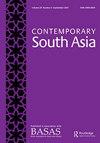南亚东部的移民、地区自治和冲突:寻找家园(土地)
IF 0.5
3区 社会学
Q3 AREA STUDIES
引用次数: 0
摘要
发表于《当代南亚》(第 32 卷第 2 期,2024 年)本文章由计算机程序翻译,如有差异,请以英文原文为准。
Migration, regional autonomy, and conflicts in Eastern South Asia: searching for a home(land)
Published in Contemporary South Asia (Vol. 32, No. 2, 2024)
求助全文
通过发布文献求助,成功后即可免费获取论文全文。
去求助
来源期刊

Contemporary South Asia
AREA STUDIES-
CiteScore
2.10
自引率
0.00%
发文量
82
期刊介绍:
The countries of South Asia - Bangladesh, Bhutan, India, Maldives, Nepal, Pakistan and Sri Lanka - are internally diverse and part of global flows of people, goods and ideas. Contemporary South Asia seeks to address the issues of the region by presenting research and analysis which is both cross-regional and multi-disciplinary. The journal encourages the development of new perspectives on the study of South Asia from across the arts and social sciences disciplines. We also welcome contributions to pan-regional and inter-disciplinary analysis. Our aim is to create a vibrant research space to explore the multidimensional issues of concern to scholars working on South Asia and South Asian diasporas in the postcolonial era.
 求助内容:
求助内容: 应助结果提醒方式:
应助结果提醒方式:


